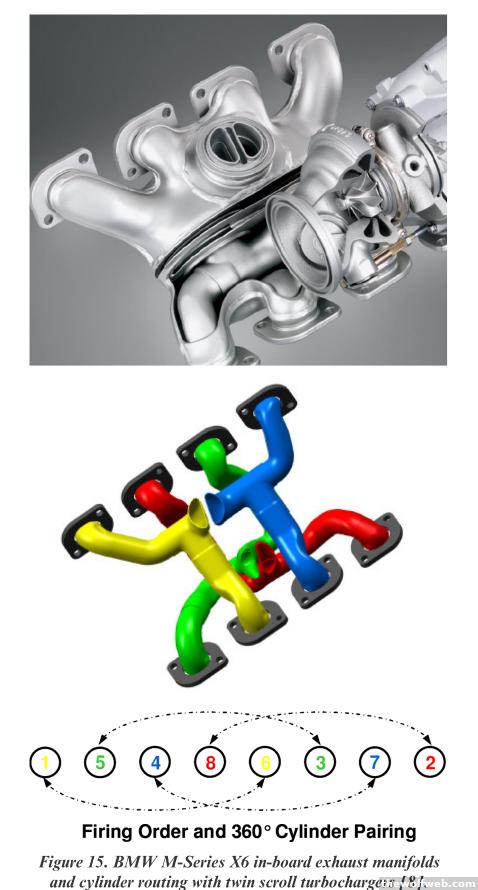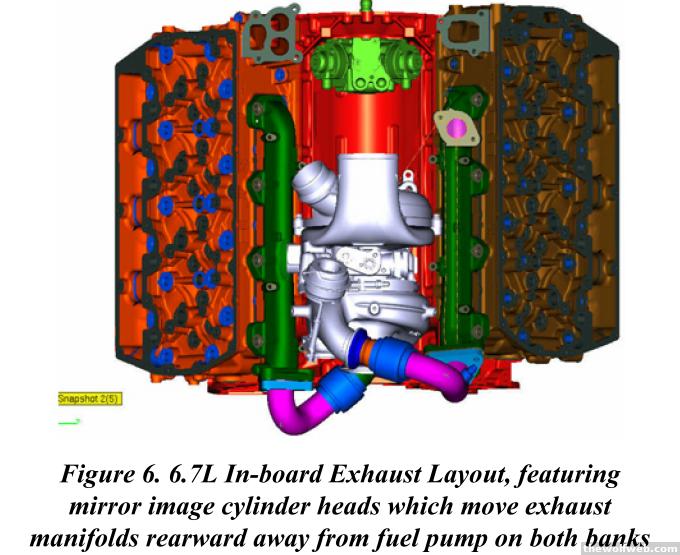danmangt40
All American
2349 Posts
user info
edit post |
Seems like a newly embraced practice (even though not a new idea) for a number of high-powered motors is putting the exhaust on top of an engine, especially where it could mean putting a turbo closer to the exhaust ports for either faster-spooling the exhaust turbine or for funneling heat out of the engine bay more efficiently.
some applications:
-Audi s6/s8/bentley continental v8's 4.0L turbo v8
-BMW 'twinpower' v8 family: x5/x6 'xdrive50i' (still a 4.4L turbo v8), x5 m, x6 m, 550i (sedan, touring, 'GranTurismo' (otw 5GT... ugh),
-Gm's aborted 4.5L v8 diesel that was supposedly considered for the CTS
http://www.autoblog.com/2009/03/11/gm-4-5l-light-duty-diesel-v8-indefinitely-postponed/
-Harmon's splinter wood car...
http://novosedlik.com/wp-content/uploads/2011/06/woodcarengine.jpg
http://novosedlik.com/2011/06/14/wooden-lovely/
so: I have two interests here:
(1) any others you can think of (some formula 1 car from the 60s definitely had this, maybe a lotus? ok, found one, the ferrari 312.. but I think there were others...another... honda ra300...)
and
(2) has this ever been done with FLAT engines?
the second one seems the most peculiar by its absence, as I'd just assume there must be a huge heat buildup under a flat engine coming off the exhaust manifold. With the exhaust on top, in some mid-engined applications, you'd have the option of even running the exhaust straight out the top of the car or at least at similar height to something like the 'bundle of snakes' collectors used in Ford GT40 replicas and other sports/racing cars that don't have to worry about a rear trunk. In addition to that, intake plumbing seems much easier to run in tight places, such as under an engine which sits parallel to the ground.
Even where exhaust still needs to run out the back of an engine, like a subaru flat-4 or flat-6, (not to mention all the inverted-head v8 production engines I've listed above that DO use exhaust on top), where the exhaust would still need to be then run down the back of the engine to pass under the car, there should still be significant benefits to heat dissipation to placing the exhaust manifolds, and as much of the exhaust componentry that has to be within the engine bay, as high as possible, right?  6/7/2012 8:08:31 PM 6/7/2012 8:08:31 PM
|
underPSI
tillerman
14084 Posts
user info
edit post |
isn't the new 6.7 powerstroke's heads reversed?  6/7/2012 8:54:59 PM 6/7/2012 8:54:59 PM
|
Dr Pepper
All American
3583 Posts
user info
edit post |
edit, i read 'flat head' not 'flat' engines
[Edited on June 8, 2012 at 9:37 AM. Reason : mybad]  6/8/2012 9:36:32 AM 6/8/2012 9:36:32 AM
|
sumfoo1
soup du hier
41043 Posts
user info
edit post |
Who cares on a flat engine...
basically all you're doing is changing the side the oil pan is on... which is what someone would say you did... not reversed the heads on the engine.
they're 180* apart so its not like its inside the v or outside.  6/8/2012 9:52:21 AM 6/8/2012 9:52:21 AM
|
danmangt40
All American
2349 Posts
user info
edit post |
the main reason why I care is for exhaust routing in the context of a mid-engined car. Not that I actually have any particular one in mind. With a low, flat engine, it seems like it would be a good idea to put the hot side on top, where it can more easily escape an engine bay, assuming it was directly open to the back with a screen or open to the top either through a vented window or with vents surrounding a window, like on an f430, or something with a flat vented panel like an esprit or diablo. I also imagine there ought to be more room, at least in a mid-engined car, with an unobstructed vertical path to a vented panel/window, to run well-proportioned headers and prevent heat from transferring to other, generally lower, more tightly packed components.
I guess it wouldn't make sense in something like a boxster, where there's closed bodywork and little space between the underside of a folding-top's compartment and the top of the motor, but it just seems like intake plumbing, especially in naturally aspirated cars, can usually be efficiently arranged in tighter spaces than exhaust manifolds. I guess if the cayman were a full-height-bulkhead sort of mid-engined car, then that would be a good example, but its weird continuous interior all the way to the trunk, over closed bodywork, doesn't really encourage that. I guess the only other flat-six mid-engined cars I can think of right off the top of my head would be the ruf ctr3, the old 911 gt1s, and the 9ff gt9. All of those kept the exhaust on the bottom.  6/8/2012 7:49:26 PM 6/8/2012 7:49:26 PM
|
arghx
Deucefest '04
7584 Posts
user info
edit post |
On a flat engine, if you put the exhaust side on the top you've just made intake packaging more difficult. Most vehicles for passenger car applications have exhaust exiting at the rear, on the bottom of the vehicle. And then the air intakes are on the top. If you have a really long and convoluted intake system it can affect resonance tuning on a naturally aspirated application. If you are doing some kind of non-street application then you have a lot less constraints.
I've commented on the V8 gas engine here: http://www.thewolfweb.com/message_topic.aspx?topic=617123&page=3 about halfway down. It applies specifically for 90 degree V8 engines because of the weird firing order. Basically, they are doing the inboard exhaust ports because they can design exhaust/turbo manifolds that separate exhaust pulses better.

When you separate exhaust pulses you have reduced residual gases in the combustion chamber and reduced pumping losses. That's why you have 2 twin-scroll turbos on those BMWs. They're expensive cars so such an expensive design is more feasible.
For the 6.7 diesel, the inboard exhaust was driven by packaging considerations and a desire for shorter exhaust piping to improve turbocharger response and catalyst light off.

With the turbo mounted in the rear, the EGR system can be bolted to the front right manifold (pinkish flange in image above). When you think of EGR you think of some stupid and maybe inaccessible valve that always gets gummed up, throwing a code on your mom's old Pontiac Grand AM or something. It's something you wish you could just throw in the trash, because its real-world effects are nill.
Modern cooled EGR is very important on a modern diesel and will be soon be found on boosted gas engines. Cooled EGR is also driving turbocharger development. By lowering combustion temperatures, it reduces NOx emissions and improves fuel consumption on the diesel. On a boosted gas engine, it is a new method for suppressing knock. Lots of companies have cooled EGR in development for future gas engines.
Getting back to the 6.7: keep in mind that this is an expensive engine. The customer pays thousands more dollars for the diesel option, but that is typically justified because the diesels are used as work trucks. I would be surprised to see inboard exhaust on high volume applications for regular consumers. It doesn't make a lot of sense.
[Edited on June 9, 2012 at 9:52 AM. Reason : .JPG]  6/9/2012 9:48:53 AM 6/9/2012 9:48:53 AM
|
|
